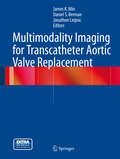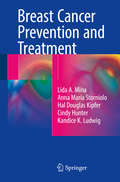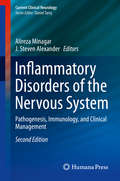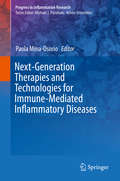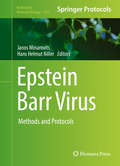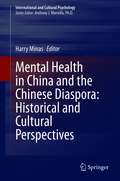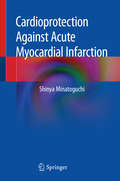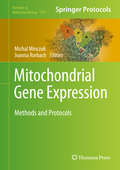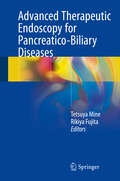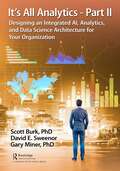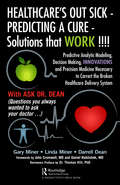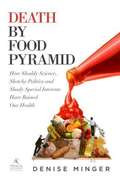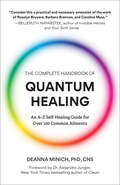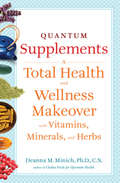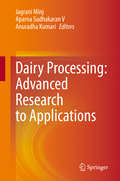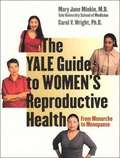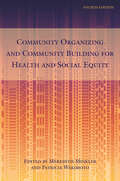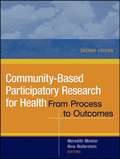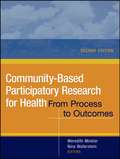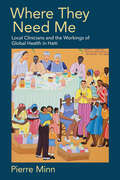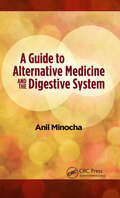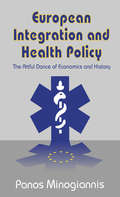- Table View
- List View
Multimodality Imaging for Transcatheter Aortic Valve Replacement
by James K. Min Daniel S. Berman Jonathon LeipsicThis book is ideal for cardiovascular imagers of all backgrounds as well as proceduralists (surgeons and interventional cardiologists) performing TAVR. This text is also of value for the physicians and nurses involved in the care of these patients, and for fellows-in-training. This practical text brings together guidance on using multi-modality imaging in one book and highlights its usage with a focus on patient care. Pre-procedural, Intra-procedural and Long-term follow up), this review offers expert opinion and evidence-based guidance on how to incorporate the various imaging modalities at each step in the care of a TAVR patient. Although much has been learned in the short span of time since TAVR was introduced into the field, our book will also offer recommendations for clinically-relevant research areas that will lead to best practice strategies for incorporating multi-modality imaging into TAVR patient care.
Breast Cancer Prevention and Treatment
by Lida A. Mina Anna Maria Storniolo Hal Douglas Kipfer Cindy Hunter Kandice K. LudwigUniquelydesigned for oncologists and general practitioners, this book offers clinicianscomprehensive guidelines when dealing with women at high risk for breastcancer. Written by experts in the field on the cutting edge of this research,the following questions will be answered for the reader by the end of the book: · Who is at elevated risk for breast cancer? · Who should be genetically screened? · When and how often should we obtain imaging? · What type of imaging is adequate? · What medications are available for prevention? · When is surgical intervention appropriate? · What lifestyle changes should be implemented to prevent thisdisaster? With one in eight women likely to contract breast cancer in herlifetime, the significance of identifying and managing the high-risk patient isevident. Breakthroughs in the identification of genes associated with breastcarcinoma, particularly BRCA1 and 2,as well as other risk factors, influence not only how patients are screened,but also how they are treated. Breast Cancer Prevention and Treatment providesa guided approach to prevention of breast cancer in women at elevated risk forthis malignancy.
Inflammatory Disorders of the Nervous System
by Alireza Minagar J. Steven AlexanderA cutting-edge review of the fundamental biological principles underlying the more common inflammatory disorders of the nervous system. The authors provide extensive updates on the latest findings concerning the mechanisms of inflammation and introduce such new concepts and methodologies as "endothelial and leukocyte microparticles" and "gene microarray technology" to help explain important links between the central nervous system (CNS) and general inflammatory processes. Among the diseases examined from an inflammatory perspective are multiple sclerosis, acute disseminated encephalomyelitis, optic neuritis, transverse myelitis, CNS vasculitis, neuropsychiatric systemic lupus erythematosis, Alzheimer's disease, and Parkinson's disease. The role of the immune system in neuroinflammation is also explored in such disorders as neurosarcoidois, HIV-Associated dementia, and HTLV-associated neurological disorders.
Next-Generation Therapies and Technologies for Immune-Mediated Inflammatory Diseases
by Paola Mina-OsorioAs our understanding of immune mediated chronic inflammatory diseases (IMIDs) grows, it becomes more and more clear that these conditions result from the convergence of a multitude of pathogenic mechanisms whose relative individual contribution is different in different patient subsets. Promising new technologies have been conceived that address the hypotheses that targeting multiple pathways simultaneously, selectively delivering therapeutics to areas of inflammation and/or resetting the immune system, could take efficacy to new levels. However, we have long waited for the arrival of some of these technologies to the bedside, or even far enough in the drug development process in spite of the initial enthusiasm. Some of the examples covered in this book include bispecific antibodies and genomic medicines, microparticles and targeted delivery of drugs to inflamed vasculature. Most published reviews and book chapters on novel therapies for inflammatory diseases describe positive attributes of molecules or technologies under investigation and the rationale for developing them into therapeutics. The originality and potential value of this book is not in the description of these targets or technologies from the point of view of their structure or mechanism of action exclusively, but rather, in making an effort to critically address the question of what is needed to move these technologies into the clinic. Has the technology not made it past the preclinical stage and why? Has it already been tested in humans and failed? What are the potential reasons behind those failures? What do experts in each field believe can be done better to increase the probabilities of success? In addition, the authors address the competitive landscape and summarize clinical studies that have failed in the respective area. They talk about the patient populations that would be required for the successful conduction of a clinical trial to test certain molecules, and they proactively share their views regarding both the potential and the drawbacks of targets or methodologies.
Epstein Barr Virus
by Janos Minarovits Hans Helmut NillerThis volume explores data from the applications of molecular biological methods and the applications of recent immunological and cytogenetic methods in Epstein-Barr Virus (EBV) that will offer readers possible new solutions to the unresolved problems in the EBV field. Chapters in this book cover topics such as: viral life cycle, latency, EBV-associated diseases and EBV diagnostics; in vitro methods including organotypic cultures for the analysis of EBV-epithelial cell interactions; identification of the interacting viral and cellular proteins using affinity purification-mass spectrometry methods; 3D telomere FISH; transcription analysis using high-throughput RNA sequencing, qPCR and nuclear run-on assay; analysis of viral and cellular microRNAs; isolation and characterization of exosomes and the assessment of their function; characterization of the viral genome by terminal repeat analysis and sequencing; the use of chromatin immunoprecipitation coupled sequencing (ChIP-Seq) for the analysis of Zta-DNA interactions; epigenetic analysis by bisulfite sequencing and ChIP; novel in vivo models for the study of EBV infection; and how immunological, virological, tissue culture and molecular methods can be combined to yield Good Manufacturing Practice-compliant EBV-specific T cells for the immunotherapy of EBV-associated post-transplant lymphoproliferative diseases (PTLD). Written in the highly successful Methods in Molecular Biology series format, chapters include introductions to their respective topics, lists of the necessary materials and reagents, step-by-step, readily reproducible laboratory protocols, and tips on troubleshooting and avoiding known pitfalls. Cutting-edge and comprehensive, Epstein Barr-Virus: Methods and Protocols is a valuable resource for anyone who is interested in this fascinating and evolving field.
Patho-Epigenetics of Infectious Disease
by Janos Minarovits Hans Helmut NillerEpigenetic modification of cellular genomes is a fascinating means of regulating tissue- and cell type-specific gene expression in all developmental stages of the life of an organism. Carefully orchestrated processes, such as DNA methylation and a plenitude of specific histone modifications secure the faithful transmission of gene expression patterns to progeny cells. Upon chronic infection, the epigenetic cellular balance can become disrupted and, in the long run, through the epigenetic reprogramming of host cell genomes, contribute to the malignant conversion of formerly healthy cells, in many cases preceded by the establishment of an epigenetic field of cancerization. The present volume undertakes to highlight the interactions of infectious pathogens and their effector molecules with the epigenetic regulatory machinery of the cell. Clearly, the recent take-off of epigenetics research did not leave Research on Infectious Diseases and Infection-Associated Cancer untouched. This resulted in a great many of clinically relevant data on understanding the molecular mechanisms of chronic infectious disease. Infectious pathogen- and disease-specific epigenetic alterations are already being used for the early detection of malignant disease and for the prediction of chemotherapy resistance or response to treatment.
Mental Health in China and the Chinese Diaspora: Historical and Cultural Perspectives (International and Cultural Psychology)
by Harry MinasFollowing on the previous volume, Mental Health in Asia and the Pacific, which was co-edited with Milton Lewis, this book explores historical and contemporary developments in mental health in China and Chinese immigrant populations. It presents the development of mental health policies and services from the 19th Century until the present time, offering a clear view of the antecedents of today’s policies and practice. Chapters focus on traditional Chinese conceptions of mental illness, the development of the Chinese mental health system through the massive political, social, cultural and economic transformations in China from the late 19th Century to the present, and the mental health of Chinese immigrants in several countries with large Chinese populations. China’s international political and economic influence and its capabilities in mental health science and innovation have grown rapidly in recent decades. So has China’s engagement in international institutions, and in global economic and health development activities. Chinese immigrant communities are to be found in almost all countries all around the world. Readers of this book will gain an understanding of how historical, cultural, economic, social, and political contexts have influenced the development of mental health law, policies and services in China and how these contexts in migrant receiving countries shape the mental health of Chinese immigrants.
Cardioprotection Against Acute Myocardial Infarction
by Shinya MinatoguchiThis book will provide readers with a detailed understanding of the ischemic damage to the myocardium after myocardial infarction, as well as essential tools for the treatment of damaged heart after myocardial infarction. It discusses various methods such as pharmacological pre- and post-conditioning, cytokine therapy, and cell therapy especially using Muse cells.The coverage of Muse cell therapy, which includes the latest work done by the author and his collaborators, is a unique feature of the book. Muse cells have self-renewability and have ability to differentiate into cells with the characteristics of all three germ layers from a single cell, while they are non-tumorigenic. It is the first book to feature the Muse cell therapy, which may offer the new promising therapeutic strategy for acute myocardial infarction.
Mitochondrial Gene Expression: Methods and Protocols (Methods in Molecular Biology #2192)
by Michal Minczuk Joanna RorbachThis volume details the most recent advancements in the field of mitochondrial gene expression. Chapters guide readers through methods and protocols on mtDNA replication, transcription, and translation to membrane insertion of the mtDNA-encoded protein products. Written in the highly successful Methods in Molecular Biology series format, chapters include introductions to their respective topics, lists of the necessary materials and reagents, step-by-step, readily reproducible laboratory protocols, and tips on troubleshooting and avoiding known pitfalls. Authoritative and cutting-edge, Mitochondrial Gene Expression: Methods and Protocols aims to provide complementary approaches and practical guidelines. Chapter 7 is available Open Access under a Creative Commons Attribution 4.0 International License via link.springer.com.
Sleeping Through the Night: How Infants, Toddlers, and Parents Can Get a Good Night's Sleep
by Jodi A. MindellRight after "Is it a boy or a girl?" and "What's his/her name?," the next question people invariably ask new parents is "Are you getting any sleep?" Unfortunately, the answer is usually "Not much." In fact, studies show that approximately 25% of young children experience some type of sleep problem and, as any bleary-eyed parent will attest, it is one of the most difficult challenges of parenting. Drawing on her ten years of experience in the assessment and treatment of common sleep problems in children, Dr. Jodi A. Mindell now provides tips and techniques, the answers to commonly asked questions, and case studies and quotes from parents who have successfully solved their children's sleep problems. Unlike other books on the subject, Dr. Mindell also offers practical tips on bedtime, rather than middle-of-the-night-sleep training, and shows how all members of the family can cope with the stresses associated with teaching a child to sleep.
Advanced Therapeutic Endoscopy for Pancreatico-Biliary Diseases
by Tetsuya Mine Rikiya FujitaComprehensively covering various techniques such as ERCP, EUS, EST and lithotripsy, this book highlights innovative endoscopic surgical techniques for managing pancreatico-biliary. It will provide readers an extensive overview of the therapeutic endoscopy management solutions and techniques currently available.Advanced Therapeutic Endoscopy for Pancreatico-Biliary Diseases was written by pioneering experts from around the world, providing a concise yet comprehensive summary of the current state of therapeutic endoscopic techniques in a step-by-step format. Each chapter examines both major and subtle yet important techniques, together with new findings, an approach that will appeal to a broad readership, from beginning to advanced endoscopists and surgeons with a background in gastroenterology, particularly those specializing in endoscopy of pancreatico-biliary diseases to help guide patient management.
It's All Analytics - Part II: Designing an Integrated AI, Analytics, and Data Science Architecture for Your Organization
by Gary Miner Scott Burk David SweenorUp to 70% and even more of corporate Analytics Efforts fail!!! Even after these corporations have made very large investments, in time, talent, and money, in developing what they thought were good data and analytics programs. Why? Because the executives and decision makers and the entire analytics team have not considered the most important aspect of making these analytics efforts successful. In this Book II of "It’s All Analytics!" series, we describe two primary things: 1) What this "most important aspect" consists of, and 2) How to get this "most important aspect" at the center of the analytics effort and thus make your analytics program successful. This Book II in the series is divided into three main parts: Part I, Organizational Design for Success, discusses ……. The need for a complete company / organizational Alignment of the entire company and its analytics team for making its analytics successful. This means attention to the culture – the company culture culture!!! To be successful, the CEO’s and Decision Makers of a company / organization must be fully cognizant of the cultural focus on ‘establishing a center of excellence in analytics’. Simply, "culture – company culture" is the most important aspect of a successful analytics program. The focus must be on innovation, as this is needed by the analytics team to develop successful algorithms that will lead to greater company efficiency and increased profits. Part II, Data Design for Success, discusses ….. Data is the cornerstone of success with analytics. You can have the best analytics algorithms and models available, but if you do not have good data, efforts will at best be mediocre if not a complete failure. This Part II also goes further into data with descriptions of things like Volatile Data Memory Storage and Non-Volatile Data Memory Storage, in addition to things like data structures and data formats, plus considering things like Cluster Computing, Data Swamps, Muddy Data, Data Marts, Enterprise Data Warehouse, Data Reservoirs, and Analytic Sandboxes, and additionally Data Virtualization, Curated Data, Purchased Data, Nascent & Future Data, Supplemental Data, Meaningful Data, GIS (Geographic Information Systems) & Geo Analytics Data, Graph Databases, and Time Series Databases. Part II also considers Data Governance including Data Integrity, Data Security, Data Consistency, Data Confidence, Data Leakage, Data Distribution, and Data Literacy. Part III, Analytics Technology Design for Success, discusses …. Analytics Maturity and aspects of this maturity, like Exploratory Data Analysis, Data Preparation, Feature Engineering, Building Models, Model Evaluation, Model Selection, and Model Deployment. Part III also goes into the nuts and bolts of modern predictive analytics, discussing such terms as AI = Artificial Intelligence, Machine Learning, Deep Learning, and the more traditional aspects of analytics that feed into modern analytics like Statistics, Forecasting, Optimization, and Simulation. Part III also goes into how to Communicate and Act upon Analytics, which includes building a successful Analytics Culture within your company / organization. All-in-all, if your company or organization needs to be successful using analytics, this book will give you the basics of what you need to know to make it happen.
HEALTHCARE's OUT SICK - PREDICTING A CURE - Solutions that WORK !!!!: Predictive Analytic Modeling, Decision Making, INNOVATIONS and Precision Medicine Necessary to Correct the Broken Healthcare Delivery System
by Linda Miner Gary D. Miner Darrell L. DeanThe U.S. healthcare system is in "complete chaos-disarray." Medical costs have increased significantly over the past 6 years with 70% increase for deductibles and 24% or more for health insurance premiums. All the while, workers earnings have either not increased or if they did, the pay raises were for less than the increase in the cost of medical care. The situation is unsustainable and the public wants the system fixed. This book offers ways of fixing the problems in healthcare. HEALTHCARE's OUT SICK - PREDICTING A CURE - Solutions that WORK !!!! first defines the "healthcare in crisis" problem. Through real patient experiences, the book describes the difficulties of getting through the maze of complexity among the plethora of "silo providers" which make up the industry. The heart of the book provides readers with a comprehensive solution that can work, a disruption that is necessary to provide Americans the medical care they need without the US public and healthcare providers and payors going into bankruptcy, insolvency or closure. This book delves into digitized medicine, payor and provider reimbursement models, and value-based healthcare delivery. It also includes a philosophy or mode of thinking and operation for the solutions that are needed for diagnosis-effective, cost-effective, and time-efficient healthcare delivery, of which digitized medicine, value-based care, and payor reimbursement modes are just some of the factors. The authors propose that the real solution involves having the patient at the center of the issues and changing from an archaic gold standard way of thinking to a "Predictive Analytic thinking" where one gets at the real truth by doing "real science" that in the end becomes effective not only for the population but for the individual person. This all leads to real person-centered and person-directed medicine and healthcare delivery.
Cancer Management in Man: Chemotherapy, Biological Therapy, Hyperthermia And Supporting Measures (Cancer Growth and Progression #13)
by Boris MinevThis book represents a comprehensive description and evaluation of the most up-to-date approaches to cancer management. Each chapter, prepared by leading basic researchers and clinicians, provides an in depth description of a specific method for cancer management. The chemotherapy section of the book is updated to include the newest drugs as well as those currently in development. Organized by drug class, this section provides the latest information on most drugs, including their mechanisms of action, interactions with other agents, toxicities, side effects, and mechanisms of resistance. The biological therapy section of the book provides expanded coverage of the currently used cytokines, vaccines, and cell based therapies of cancer. Full consideration is also given to other modern treatment approaches, such as tyrosine kinase inhibitors, inhibitors of tumor angiogenesis, and the transcatheter management of cancer. Current advances in hyperthermia in cancer treatment, hematologic and nutritional support, bone marrow transplantation, pain management and care of the terminally ill patients with cancer are also presented. In summary, this book provides a comprehensive coverage of the current knowledge on the most innovative, systematic and multidisciplinary approaches to the treatment of patients with cancer.
Death By Food Pyramid: How Shoddy Science, Sketchy Politics And Shady Special Interests Have Ruined Our Health
by Denise MingerWarning: Shock and outrage will grip you as you dive into this one-of-a-kind expos#65533;. Shoddy science, sketchy politics and shady special interests have shaped American Dietary recommendations--and destroyed our nation's health--over recent decades. The phrase Death by Food Pyramid isn't shock-value sensationalism, but the tragic consequence of simply doing what we have been told to do by our own government--and giant food profiteers--in pursuit of health. In Death by Food Pyramid, Denise Minger exposes the forces that overrode common sense and solid science to launch a pyramid phenomenon that bled far beyond US borders to taint the eating habits of the entire developed world. Denise explores how generations of flawed pyramids and plates endure as part of the national consciousness, and how the "one size fits all" diet mentality these icons convey pushes us deeper into the throes of obesity and disease. Regardless of whether you're an omnivore or vegan, research junkie or science-phobe, health novice or seasoned dieter, Death by Food Pyramid will reframe your understanding of nutrition science, and inspire you to take your health, and future, into your own hands.
The Complete Handbook of Quantum Healing: An A–Z Self-Healing Guide for Over 100 Common Ailments
by Deanna MinichThe Holistic Healing Handbook for a Homeopathic Household“A thoughtful, comprehensive synthesis of a multifaceted approach to healing” —Belleruth Naparstek, LISW, BCD, creator of the Health Journeys Guided Imagery series#1 New Release in Diseases & Physical AilmentsHeal your body naturally using an array of well-researched and long-practiced techniques. This easy-to-understand holistic healing library provides multiple healing approaches to the most common ailments, so you’ll have access to the best approach for you and will be feeling better in no time.Holistic healing made easy. Our lives are intertwined with the unexpected. We are bound to become ill or get hurt, probably multiple times in our lives. When that happens, Complete Handbook of Quantum Healing makes healing your body easy by providing an A-Z reference guide of over 100 health issues, each with healing options using different types of holistic medicine, so you’ll be sure to find the best approach —or approaches —for you.See real results through trusted techniques. A perfect holistic healing gift or addition to anyone’s natural health kit, Complete Handbook of Quantum Healing seamlessly blends new-world science with old-world knowledge. With her deep understanding of both the medical and the spiritual side of healing, author Deanna Minich, PhD, translates her medical knowledge to simple holistic healing techniques that anyone can use and that have been shown to work.Inside, you’ll find:An A-Z list of over 100 common ailments7 self-healing options for each ailment including herbal medicines, essential oils, crystals, and moreSelf healing quotes, meditations, and healing energy exercises to restore the body and the soulIf you like natural healing books such as The Modern Herbal Dispensary, Medical Medium, or When the Body Says No, you’ll love Complete Book of Quantum Healing.
Quantum Supplements: A Total Health and Wellness Makeover with Vitamins, Minerals, and Herbs (Conari Wellness)
by Deanna M. MinichQuantum Supplements bridges together the seemingly disparate scientific and spiritual realms through popular modern-day concepts - dietary supplements and nutrition and the ancient chakra system - to help people explore the every growing field of energy medicine. This user-friendly, cutting edge guide explains the "energy healing" and vibrational properties of vitamins, minerals, and herb/botanicals, specifically their effects on activating and balancing the body's natural energy centers. Following a practical overview to the different types of dietary supplements and how they work, the author elaborates on the physiological and psychological activities of each energy center, or chakra, and the supplemental nutrients that assist their balance. The book includes many easy-to read tables and charts are provided as a quick reference guide to determining which supplements are most appropriate for any and everything from bolster the immune system to fight off frequent colds to improving circulation to fighting memory loss.
Dairy Processing: Advanced Research to Applications
by Jagrani Minj Aparna Sudhakaran V Anuradha KumariThis book focuses on advanced research and technologies in dairy processing, one of the most important branches of the food industry. It addresses various topics, ranging from the basics of dairy technology to the opportunities and challenges in the industry. Following an introduction to dairy processing, the book takes readers through various aspects of dairy engineering, such as dairy-based peptides, novel milk products and bio-fortification. It also describes the essential role of microorganisms in the industry and ways to detect them, as well as the use of prebiotics, and food safety. Lastly, the book examines the challenges faced, especially in terms of maintaining quality across the supply chain. Covering all significant areas of dairy science and processing, this interesting and informative book is a valuable resource for post-graduate students, research scholars and industry experts.
The Yale Guide to Women's Reproductive Health: From Menarche to Menopause
by Mary Jane Minkin Carol V. WrightThis book is for every woman who has wished for an unhurried, personal conversation with a sympathetic doctor who will answer her questions about reproductive health. With warmth and understanding, the authors respond to questions about the gynecological issues that concern women today.
Community Organizing and Community Building for Health and Social Equity, 4th edition
by Meredith Minkler Patricia Wakimoto Lionel J. Beaulieu Adam B. Becker Lynn Blanchard Anne Bluethenthal Frances Dunn Butterfross Lisa Cacari Stone Caricia Catalani Charlotte Yu-Ting Chang Roxana Chen Wayland X. Coleman Chris M. Coombe Jason Corburn Lori Dorfman Eugenia Eng Nancy Epstein Jessica Estrada Jennifer Falbe Stephanie A. Farquhar Prisila Gonzalez Joseph Griffin Leslie Grover Lorraine Gutiérrez Trevor Hancock Susana Hennesey Laverty Reva Hines Mark S. Homan Lili Farhang Solange Gould Cheryl A. Hyde Barbara A. Israel Anthony B. Iton Whitney Johnson Michelle C. Kegler Josh Kirschenbaum John P. Kretzmann Ronald Labonté Blishda Lacet Pam Tau Lee Edith A. Lewis Jennifer Lifshay Laura Linnan Shaw San Liu Shaddai Martinez Cuestas Marty Martinson John L. McKnight Christine Mitchell Rachel Morello-Frosch Mary Anne Morgan Angela Ni Barack Obama Edith A. Parker Susan Racine Passmore Manuel Pastor Amber Akemi Piatt Cheri A. Pies Clara Pinsky R. David Rebanal Kathleen M. Roe Zachary Rowe Alicia L. Salvatore Shannon Sanchez-Youngman Amy J. Shulz Rinku Sen Lee Staples Celina Su Makani Themba Stephen B. Thomas Maria Elena Torre Evan Vandommelen-Gonzalez Dierde Visser Nina Wallerstein Tom Wolff Kirsten Wysen Marisa Ruiz Asari Nickie Bazell Derek M Griffith Heather CameThe fourth edition of Community Organizing and Community Building for Health and Social Equity provides both classic and recent contributions to the field, with a special accent on how these approaches can contribute to health and social equity. The 23 chapters offer conceptual frameworks, skill- building and case studies in areas like coalition building, organizing by and with women of color, community assessment, and the power of the arts, the Internet, social media, and policy and media advocacy in such work. The use of participatory evaluation and strategies and tips on fundraising for community organizing also are presented, as are the ethical challenges that can arise in this work, and helpful tools for anticipating and addressing them. Also included are study questions for use in the classroom. Many of the book’s contributors are leaders in their academic fields, from public health and social work, to community psychology and urban and regional planning, and to social and political science. One author was the 44th president of the United States, himself a former community organizer in Chicago, who reflects on his earlier vocation and its importance. Other contributors are inspiring community leaders whose work on-the-ground and in partnership with us “outsiders” highlights both the power of collaboration, and the cultural humility and other skills required to do it well. Throughout this book, and particularly in the case studies and examples shared, the role of context is critical, and never far from view. Included here most recently are the horrific and continuing toll of the COVID-19 pandemic, and a long overdue, yet still greatly circumscribed, “national reckoning with systemic racism,” in the aftermath of the brutal police killing of yet another unarmed Black person, and then another and another, seemingly without end. In many chapters, the authors highlight different facets of the Black Lives Matter movement that took on new life across the country and the world in response to these atrocities. In other chapters, the existential threat of climate change and grave threats to democracy also are underscored.
Community-Based Participatory Research for Health: From Process to Outcomes (Second Edition)
by Meredith Minkler Nina WallersteinAs CBPR continues to evolve as a field of practice and an orientation to research,this book throws light on the pathways linking processes to outcomes .
Community-Based Participatory Research for Health
by Meredith Minkler Nina WallersteinMinkler and Wallerstein have pulled together a fantastic set of contributions from the leading researchers in the field. In addition to a fine collection of case studies, this book puts the key issues for researchers and practitioners in a historical, philosophical, and applied, practical context
Where They Need Me: Local Clinicians and the Workings of Global Health in Haiti
by Pierre MinnWhere They Need Me examines the work of Haitian health professionals in humanitarian aid encounters. Haiti is the target of an overwhelming number of internationally funded health projects. While religious institutions sponsor a number of these initiatives, many are implemented within the secular framework of global health. Pierre Minn illustrates the divergent criteria that actors involved in global health use to evaluate interventions' efficacy.Haitian physicians, nurses, and administrative staff are hired to carry out these global health programs, distribute or withhold resources, and produce accounts of interventions' outcomes. In their roles as intermediaries, Haitian clinicians are expected not only to embody the humanitarian projects of foreign funders and care for their impoverished patients but also to act as sources of support for their own kin networks, while negotiating their future prospects in a climate of pronounced scarcity and insecurity. In Where They Need Me, Minn argues that a serious consideration of these local health care providers in the context of global health is essential to counter simplistic depictions of clinicians and patients as heroes, villains, or victims as well as to move beyond the donor-recipient dyad that has dominated theoretical work on humanitarianism and the gift.
A Guide to Alternative Medicine and the Digestive System
by Anil MinochaA Guide to Alternative Medicine and the Digestive System is unique in that it provides answers to many practical clinical questions, all in one comprehensive resource. This single-authored handbook by Dr. Anil Minocha contains content supported by close to a 1,000 scientific citations. A Guide to Alternative Medicine and the Digestive System discusses the supportive evidence, and addresses safety issues, side-effects, and drug interactions.Dr. Anil Minocha is Board-certified in gastroenterology, internal medicine, nutrition as well as fellowship trained in clinical pharmacology and medical toxicology. This extensive background brings a systematic approach to evaluating, treating, and managing patients with alternative medicine options when treating conditions related to the digestive system.Readers will find more than 70 chapters of succinct information written in a user-friendly format inside A Guide to Alternative Medicine and the Digestive System.“Dr. Anil Minocha is well-known for writing useful, practical guides for quality care. His newest text, A Guide to Alternative Medicine and the Digestive System is no disappointment. This is an eloquent and elegant evidence-based approach to a challenging area.”-Jack A. Di Palma, MD, University of South Alabama, Former President of the American College of Gastroenterology“Dr. Minocha is to be applauded for his courage in tackling an issue, CAM, that the medical profession has traditionally chosen to ignore in the hope that it would simply go away. That CAM has stubbornly refused to disappear is a testament to its popularity with the general population and demands that we take it seriously, analyze why it is used and by whom and critically assess its efficacy and risks. For providing us with an accessible, fair and comprehensive critique of CAM in the context of modern medical practice, we all owe a debt of gratitude to Dr. Minocha."-Eamonn Quigley, MD, University College Cork, Ireland , Former President of the American College of Gastroenterology
European Integration and Health Policy: The Artful Dance of Economics and History
by Panos MinogiannisThe impact of European integration on diverse national social policies is still largely unknown. While policy decision making remains at the country level, there is a strong possibility that indirectly, as a result of ideological imperatives and financial constraints, policies will change. National health policy is a case in point. This important volume explores the current and probable effect of European integration on health care protection. Will it tend to encourage all European member states to provide equitable and universal access to quality care? Or is the European integration process likely to lead to social exclusion of some? The high degree of social welfare as a health expectancy holds great significance for decisions in countries like the United States facing similiar pressures for expanded coverage. In answering these questions, Panos Minogiannis examines policies in Greece, France, Germany, and the Netherlands. Minogiannis frames his argument through an exploration of the history of the institutionalization of health care. Chapter 1 explores the nature of challenges that health care faces in an era of integration and the ways in which these challenges have emerged. Chapter 2 discusses centralization of governance in Brussels, describing the structure and relations of different European Union institutions, and their interactions with member states. The final portions of the book, through case studies of the Dutch, French, German, and Greek health reforms, explore the history of the political development of health care institutions with a particular interest in reform proposals in the last fifteen years. Chapter 7 brings together lessons from previous chapters and discusses the dynamics of health policy making in the European Union. Minogiannis concludes that health insurance will most likely remain at the member state level as far as politics are concerned, at least for the present, although policy makers will most likely have to deal with the issue of cross-border health more comprehensively than in the past. Those interested in comparative policy, and in particular health care policy, will find this volume highly informative reading. Those interested in the impact of European integration will find it provocative. Panos Minogiannis is with the Mailman School of Public Health at Columbia University and is a research associate at the Eisenhower Center.
